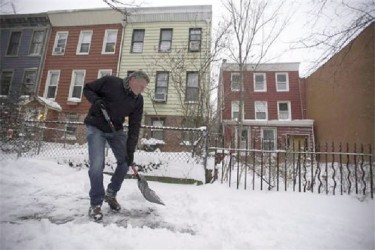NEW YORK (Reuters) – Many parts of the US Midwest braced for a blast of Arctic air this weekend that could bring some of the coldest temperatures in two decades before advancing to the Northeast, where residents are still digging out from a deadly snowstorm.

Starting today, the deep freeze will be felt in the northern US plains, including North and South Dakota, and through the Great Lakes region and Ohio Valley, according to the National Weather Service.
It will be some of the coldest weather to grip the region in two decades, with blizzard conditions expected in the Central Plains and Great Lakes regions, forecasters said.
“The last really big Arctic outbreak was 1994, said Bob Oravec, a forecaster with the National Weather Service. “Outbreaks like this don’t occur every day. They aren’t unheard of, but they are unusual.”
This push of Arctic air could bring record low temperatures in areas from Montana to Michigan, and move to the Northeast where it will arrive by early Tuesday, forecasters said.
Chicago could be about negative 20 (minus 29 Celsius), he said. Pittsburgh could see temperatures about 11 degrees below zero Fahrenheit (minus 24 Celsius) by early Tuesday.
“Incredibly, it may feel as cold as negative 50 to negative 60 (minus 45 to minus 51 Celsius) today night over sections of the north-central states,” including Minnesota and Wisconsin, the National Weather Service said in a statement.
In those conditions, frostbite can set in on exposed skin within five minutes, forecasters warned.
Preparing for the dangerous weather, officials in several states asked residents to use extra precautions when outdoors.
Minnesota Governor Mark Dayton has ordered all public schools in the state closed tomorrow to protect children from dangerously cold weather.
Chicago schools will be open Monday despite the cold but officials, in a statement, advised parents to “use their own discretion in deciding whether to send their child to school.”
In Pittsburgh, the transition team for Mayor-elect Bill Peduto said his inauguration ceremony tomorrow would be moved from the steps of the local government building to an indoor venue because of the weather.
Officials in Kentucky, which could see up to 8 inches (20 cm) of snow and freezing temperatures, were warning people to avoid road travel and stay indoors.
“If you don’t need to be out, stay in, stay home,” said Buddy Rogers, spokesman for Kentucky Emergency Management. “Take the pets inside and take the livestock inside the barns and make sure your elderly neighbours and friends are looked after.”
Schools will remain closed in Nashville, Tennessee, until Wednesday, a day after winter break was supposed to end, local officials said.
The storm comes on the heels of a massive winter weather system that slammed the U.S. Midwest and Northeast just after New Year’s Day, causing several deaths, grounding thousands of flights and forcing schools and government offices to close.
A total of 1,266 flights were canceled across the United States and 6,036 flights delayed yesterday, with Chicago’s O’Hare International Airport and Newark Liberty International Airport in New Jersey among the most affected, according to tracking firm FlightAware.com.
Molly Cox, who was in New York City for New Year’s Eve, said she missed her Friday night flight home to Denver because LaGuardia Airport was “a disaster.”
“I was told I wouldn’t be able to get a flight out until today,” she said. “With all the cancellations, all of the airlines seem to be having this kind of chaos.”
Boston was especially hard-hit by the first major storm of 2014, logging about 18 inches (45 cm) of snow on Friday, while some towns north of New England’s largest city saw close to 2 feet (60 cm) of accumulation.
But life has begun to return to normal in Boston. The city lifted its snow emergency at 5 pm on Friday.
New York City got about 7 inches (18 cm) and was slammed with overnight air temperatures hovering under the freezing mark. Washington received more than 2 inches (5 cm) of snow in the storm, Philadelphia roughly 5 inches (13 cm) and Hartford 7 inches (18 cm).




